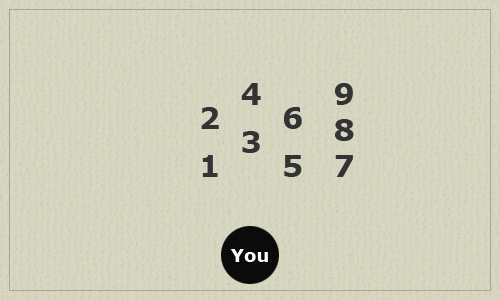Odin’s Nine Layout
We see in the story the Havamal1 that the God Odin hung on a tree (possibly Yggdrasil – the World Tree) for nine days and nights. The first six represent the God himself and the last three make up his spear, Gungnir. The set up looks like so:
The layout image isn’t much the way it looks here. Numbers 1 and 5 are suppose to be Odin’s legs and feet, numbers 2 and 6 are his arms and hands, number 3 is his body and number 4 is his head. The spear is standing up at Odin’s side and consists on numbers 7, 8 and 9. If you use a great deal of imagination you may start to see how the picture is suppose to look. To read this layout follow this guide.
The column with numbers 1 and 2 represent the past factors that have acted on the question you have asked.
- 1 – Hidden influences that acted in the past
- 2 – The questioner’s present attitude to these past events
The column with numbers 3 and 4 represent the present forces on the question.
- 3 – Hidden influences acting now
- 4 – The questioner’s attitude toward the present events
The column with the number 5 and 6 represent the outcome of the question.
- 5 – Represents hidden influences – delays or obstacles that may prevent the outcome
- 6 – Shows the questioner’s response to the result
The last column that shows Odin’s spear represents the powers you have or need to deal with each of the previous three columns.
- 7 – Deals with the powers you have or need for the first column (numbers 1 and 2)
- 8 – Deals with the powers you have or need the second column (numbers 3 and 4)
- 9 – Deals with the powers you have or need the third column (numbers 5 and 6)
Recording Sheet
If you wish to record your rune casts I’ve created a a printable recording sheet for the Odin’s Nine Layout rune cast.
[download id=”9″ format=”1″]
Odin Discovers the Runes
The Elder Edda is a book of mythological stories of the Norse gods and goddesses and it is in here where we first see Odin learn about the runes. A story called Havamal1 or “Sayings of the High One2” tells us just how Odin first learned the runes.
Odin said:
I know that I hung on a high windy tree
for nine long nights;
pierced by a spear -Odin’s pledge-
given myself to myself.
No one can tell about that tree,
from what deep roots it rises.They brought me no bread, no horn to drink from,
I gazed toward the ground.
Crying aloud, I caught up the runes;
finally I fell.
We see that Odin, in a shaman-like self-sacrificing ritual, deprives himself of food and drink as he hangs upside down on a tree. In some translations we are told that this tree is Yggdrasil, the Norse World Tree. As the days drag out longer and longer for him, nine nights pass and it is then when Odin sees the shapes of the runes. Crying out, he catches up the runes and falls from the tree.
The poem goes on talking about the runes and how Odin knows how to carve them for magickal uses. There are a total of eighteen runes that are listed but we never are told the names nor hinted at what they may look like. However if you believe the stories and tales of Guido List then you would tend to accept the Armanen Runes to be the runes that Odin discovered. Of course there is no evidence to even come close to supporting List’s claim as his rune set being the very first and original rune set.
If you are looking for the section in the Hávamál where it talks about Odin and the runes, it starts on the 138th stanza in the poem. Or if your poem doesn’t tell you the stanza number look for the section “The Lay of Loaddfafnir” (which starts on the 111th stanza). Skim a little ahead and you should see it.


